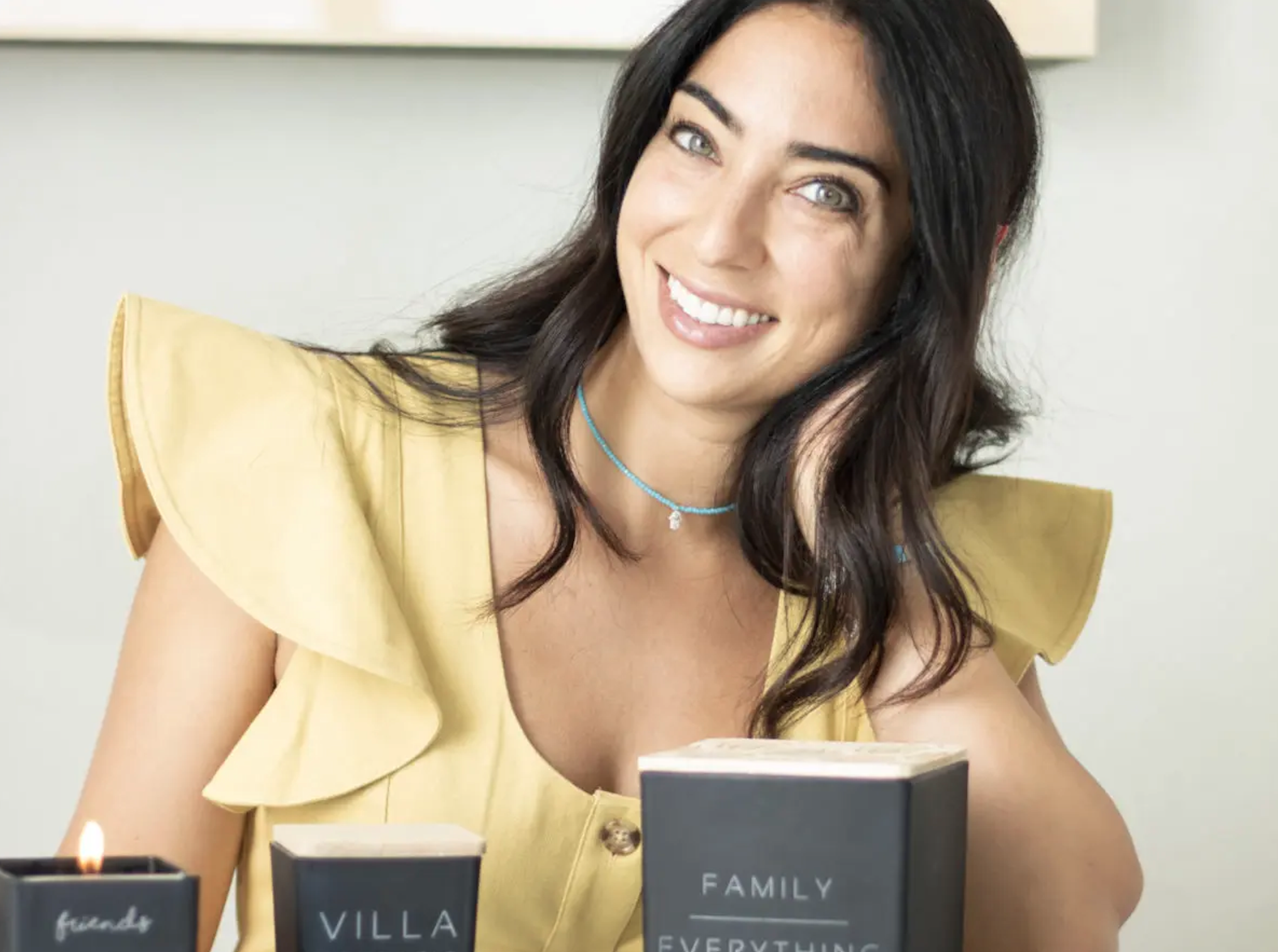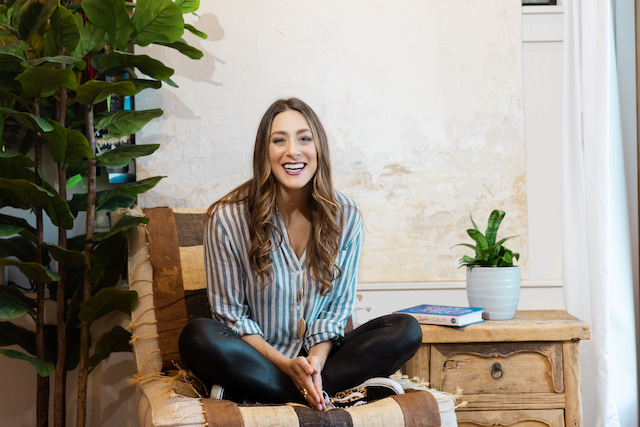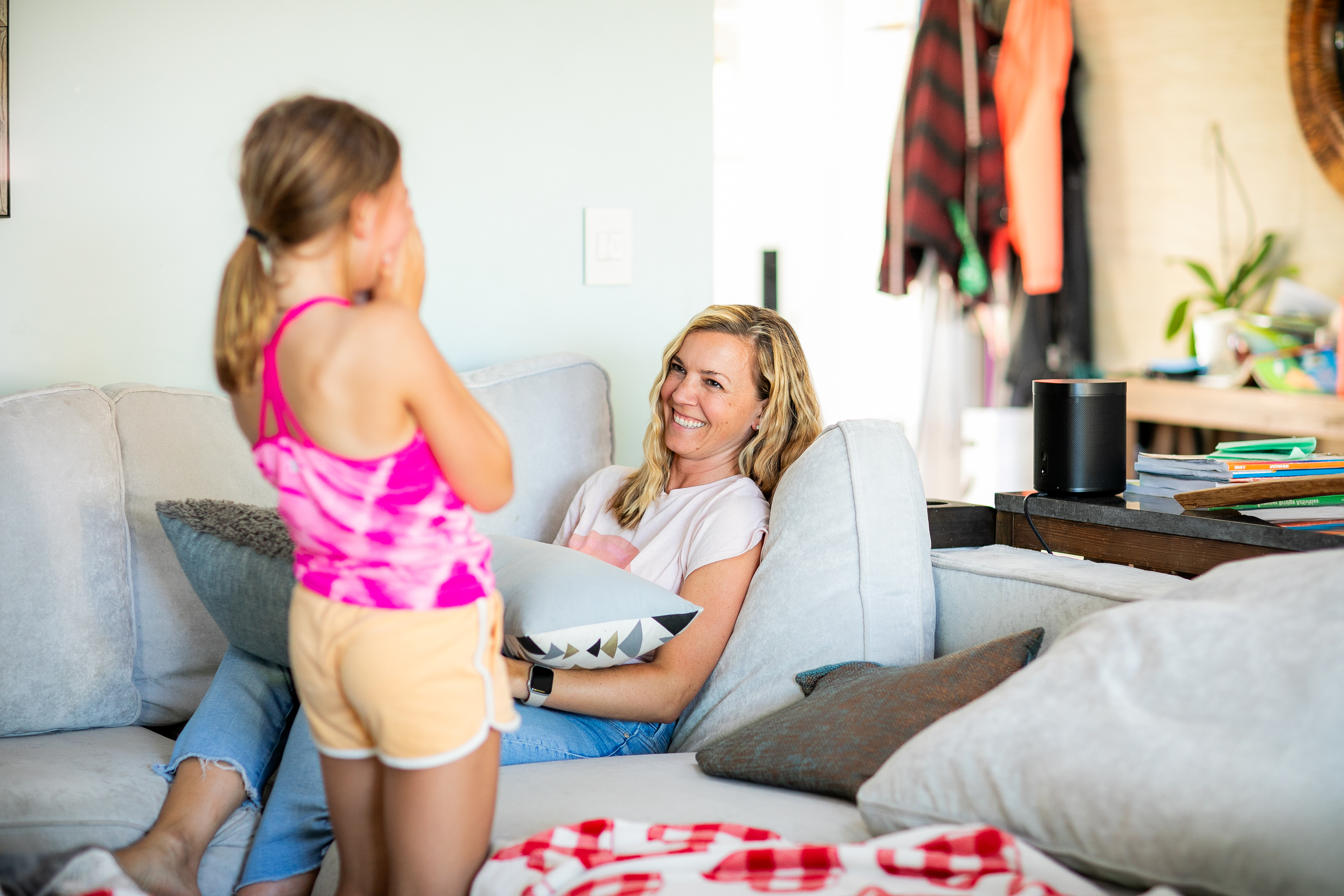8 Takeaways for Moms from Inspiring Women at the Hello Sunshine: Shineaway 2024 Event
A few weeks ago, I learned about Reese Witherspoon’s Hello Sunshine: Shine Away Event and quickly contacted their CEO, Sarah Harden to learn more and book a ticket. And boy, am I glad I did! The weekend was filled with inspiring women whose advice and messages fueled my journey to strive to build success by continuing to help busy moms shine.
As a mom of three, it took a lot to take a weekend away. But I thought—I’m always there for my kids, and this weekend will fuel my personal growth. As moms, we know how important that is and how it can inspire our children to pursue their dreams and passions in the future.
So, for all the moms needing inspiration as we head into another week, here are some top takeaways from the incredible women featured at this event. I highly recommend them to any woman looking to inspire their journey in the future. Reese’s team did not disappoint; there is something here for everyone!
Takeaways for Moms from the Shine Away 2024
Empowering women through new communities:
1) Hannah O’Flynn is Elevating Female Hoopers
The first powerhouse to take the stage was NBA commentator Hannah O’Flynn. She shared how she invested in herself and got accepted into Reese Witherspoon’s Hello Sunshine beta program this past year. Hannah highlighted a startling statistic: “Only 4% of media coverage across all sports focuses on women.” She’s working to change that daily.
She's quick to point out that the women’s games during March Madness in 2023 were watched by millions, with the Iowa vs. UConn game doubling the men's viewership. This gives her momentum to further her mission to elevate female athletes and shatter the glass backboards in every city she visits.
2) Octavia Spencer is Saying No and to Build Advocates with Like-Minded Communities
Octavia Spencer emphasized the importance of surrounding yourself with people who share your values. She explained that this support network helps her advocate for herself and know when to say no. She and Reese Witherspoon echoed that asking for help along the way is okay, too.
Octavia also shared that she’s working on a film adaptation of First Lie Wins, a thriller set in the South. She encouraged women to support each other by pre-ordering books, hitting the like button on Netflix (which influences future films), and following women-led projects.
Women in Business Advice From the Shine Away 2024 Event
3. Laura Dern Talked About “Keeping Your Eyes on Your Own Paper”
Actress and producer Laura Dern shared how she was taught to keep her eyes on her own paper at a young age and in growing up with two parents who were actors. She emphasized the importance of focusing on your journey rather than comparing yourself to others, allowing you to shine in your own right. She reminded us that “the same sun shines on all of us,” and there’s plenty of room at the table for everyone. Reese echoed the same sentiment and let everyone know it’s ok to have many things you’re involved in and not just one lane or avenue for growth.
4. Sarah Blakely Reminds Women They’re Worth Great Success
Sarah Blakely, founder of Spanx, started her company with humor and determination, famously using the tagline: "Don’t worry, we’ve got your butt covered." Despite having no advertising budget, her brand skyrocketed after being featured on ‘Oprah’s Favorite Things’ in November 2000. She shared how retailers once told her, “We’re going to war,” when she first started in a male-dominated industry. But Sarah founded Spanx on three principles—intuition, vulnerability, and empathy—and won by leading with those values. She’s now disrupting the footwear industry with her latest venture, Sneex.
5. “At the Top of Her Game” Panel Proved that Female Athletes Are Just Getting Started Disrupting Change in the Sports Industry
Candace Parker, Alex Morgan, and Diana Flores took the stage to discuss their paths to success. Diana shared her passion for flag football, which is set to debut on a global stage at the 2028 Olympics. Candace Parker reflected on the impact of Title IX and its impact on women in sports. At the same time, Alex Morgan discussed her recent retirement and her ongoing work through the Alex Morgan Foundation and Togethxr, her media company advocating for women in sports.
Women Overcoming Imposter Syndrome at the Shine Away Event
6. Imposter Syndrome Has No Place for Women in Business
During a session led by The Bright Side podcast hosts, panelists like Gaby Dalkin and Amanda Kloots tackled imposter syndrome. The session broke down four types of imposter syndrome:
- The Perfectionist: anything less than perfect is a fail
- The Natural Genius: someone for whom everything has always come very easily
- Super Woman: you try to juggle everything
- The Expert: the one who doesn’t like to be referred to as an expert
The panelists emphasized that imposter syndrome often appears when you’re on the verge of a breakthrough and shared strategies to overcome it. For example, Amanda demonstrated a yoga star pose to increase confidence and make yourself larger instead of smaller in everything you do. Hosts of the Bright Side, Simone Boyce, and Danielle Robay, discuss how competence and repetition can lead to confidence later.
7. Pivoting Careers Can Be Powerful
Another standout session featured Kate Bowler, Brooke Baldwin, Amanda Kloots, and Danielle Ponder. Each woman shared how pivoting from one career to another allowed them to find greater fulfillment. Danielle Ponder, for example, transitioned from a public defender to a music producer, while Brooke Baldwin left CNN to explore new opportunities in journalism.
Amanda emphasized that she’s learned to do less through her work with Tyler Henry and his mantras so we don’t constantly cloud our minds with what we’re doing and can look for signs instead. Another good test is to look at the past with a straightforward question: If you returned to that time, would you fit in anymore? It’s okay to change and honor all aspects of yourself. And it’s only in staying calm that we can meet the world wholeheartedly and with our best selves.
8. We Can Elevate the Future of Women’s Health and Wellness
On day two, Dr. Marie Claire, Lauren Makler, Tatyana Ali, and Naomi Watts discussed the future of women’s health. Naomi Watts, who founded Stripes Beauty, spoke about breaking the taboo around menopause. Dr. Marie Claire addressed the medical gaslighting women face and encouraged women to become their health advocates. The session ended with a powerful message: setbacks are setups for a brighter future, and the magic of change starts in rooms like these.
FINAL TAKEAWAYS FROM THE HELLO SUNSHINE SHINE AWAY 2024
This event was filled with stories and lessons that inspired me and made me eager to share with other moms. I loved meeting and networking with other powerhouse moms, like Stephanie Fornaro, Founder of Hello Nanny.com—a site dedicated to resourcing more help needed for families.
Please follow along on Instagram @MomShineco for more coverage of this incredible event.
The Mompreneur Playbook: How Annabelle DeGrazio Went from Lawyer to Building a Million-Dollar Celeb-Loved Candle Company
Annabelle DeGrazio didn’t just build a business—she started with a mission to make people happy and bring back the art of thoughtful gift-giving. Her candle company, now loved by celebrities and featured in glossy magazines, started with a clear vision, passion, and thoughtful steps. And, of course, there are challenges along the way. For moms with dreams of starting a business and capitalizing on their next big idea, here’s how Annabelle’s journey can serve as a blueprint for success.
Step 1: Make Your Main Goal Top of Mind
Annabelle prioritized creating a luxury candle brand that offered something unique to the market. Her goal wasn’t just to make candles; she wanted her products to evoke feelings of luxury and comfort. Before starting your business, define your goal—whether it’s creating a product that’s high-quality, accessible, or niche—and let that guide every decision you make. Keeping your main objective front and center will help ensure your brand remains true to its core mission all along the way.
Step 2: Get Proof of Concept Before Launching
Annabelle didn’t dive in without testing the waters first. She sought feedback from her network and tested her candle concepts at small events to gauge interest and refine the product. Before getting started, she even went to tradeshows with her prototype to test laser-engravers. Proof of concept is essential—it gives you the confidence that your idea resonates with your target audience before investing significant resources. Whether it’s running a small batch or starting with pre-orders, make sure your concept has legs before scaling it up.
Step 3: Build a Sustainable, Eco-Conscious Company
From the beginning, Annabelle considered her business's environmental impact. She chose sustainable ingredients and eco-friendly packaging and worked with manufacturers who shared her values. Today’s customers, especially celebrities and influencers, are drawn to brands aligning with their sustainability commitment. A McKinsey stat shows that 63% of all consumers surveyed consider a brand’s promotion of sustainability an important purchasing factor for products. Consider how your product can be made with the environment in mind and how to highlight that to your audience.
Step 4: Put Your Unique Spin on Your Product
The candle industry is saturated and a $3.5 billion industry. But Annabelle set herself apart by adding a unique twist—luxury fragrances inspired by nature, wrapped in minimalist yet elegant packaging. She found a way to express her vision through her products, which made them instantly recognizable. Ask yourself: How can you make your product stand out? Whether in design, materials, or branding, your personal touch will make it memorable.
Bonus Tip: Add Community or Personalization
Annabelle’s brand doesn’t just sell candles—it sells an experience. She invites her customers into a community where they can personalize their purchases or connect over shared values, like sustainability or self-care. She encourages brands to think outside the box when personalizing products for their customers. For one large hospital, she even helped them personalize the tops of the candles for patients.
Consider how you can foster community and inspire your base through a thoughtful product. That interaction with businesses and consumers alike is key to her business, and personalization sets her company apart from the rest to connect customers with her brand.
Step 5: Reach Out to Influencers in a Cost-Effective Way
Annabelle’s candles caught the attention of influencers, but she didn’t blow her budget on big celebrity endorsements right away. Instead, she leveraged micro-influencers and offered her products as gifts in exchange for posts and reviews to their like-minded audience. This built buzz around her brand and got her candles into the hands of some of the biggest names in Hollywood. Find influencers who align with your brand’s values and reach out in ways that won’t break the bank.
Step 6: Start Small and Scale Up
Annabelle didn’t try to become a global brand overnight. She started with small batches, refined her product, and scaled her business as demand grew. By starting small, she could stay focused on her original goal while being nimble enough to adjust. As your business grows, always keep your main goal in mind and make thoughtful, measured decisions that will allow you to scale effectively. She still leverages her background as a lawyer to make intelligent business decisions in hiring and employee culture as she scales.
Final Thoughts: How Annabelle DeGrazio’s Entrepreneurial Steps Can Apply to You
Annabelle DeGrazio’s journey is inspiring. Following these steps, you can create a business that aligns with your values, captures your passion, and grows with intention.
Subscribe to listen to the full episode on Thursday, 10/3, and for more of Annabelle’s top tips and tricks for mompreneurs to scale strong businesses.
4 Family Activities To Do on Your Next Trip to Japan
Since Japan opened its doors to tourists after the pandemic, I know many of my friends haven’t been able to get enough of this fantastic country. It’s tough to beat when 1 US dollar equals roughly 142 Japanese Yen.
Japan is also a vibrant cultural mix of ancient traditions and modern elements, making it an unforgettable family travel destination. I had one friend implement the purse handkerchief every woman carries to wipe their hands delicately after a bathroom visit. How clean and thoughtful, too!
Here are some tips I’ve gathered through friends and my favorite travel planner and expert, Kristina Watkins of KW Lux Travel, so you can plan your next trip to this beautiful country and create lasting memories for your family soon.
Best Things to Do in Japan with Kids
1. Book a Guide to See the Tsukiji Fish Market
For an authentic taste of Japanese culture, take a guided tour of the iconic Tsukiji Fish Market. While the inner market has moved, the outer market remains bustling with fresh seafood, local delicacies, and unique street food. A guide will help you navigate this busy spot, ensuring you get the whole experience while learning about the significance of Japan’s seafood trade.
2. Watch a Sumo Wrestling Match
Introduce your family to Japan’s national sport by attending a sumo wrestling match. These larger-than-life athletes perform ancient rituals and display incredible strength and agility. Watching sumo live is an exciting and educational way to experience a tradition that goes back centuries. It’s a spectacle the whole family will enjoy!
3. Explore teamLab Borderless Light Art Installation
teamLab Borderless is an immersive, digital art museum where the boundaries of art, technology, and imagination dissolve. Children and adults alike will be mesmerized as they walk through rooms of constantly shifting, interactive light displays. It's an inspiring, one-of-a-kind experience that transports you to a world where art and technology meet most magically.
4. Participate in a Geisha Tea Ceremony
Step into the past by joining a traditional Geisha tea ceremony. This experience allows your family to witness a geisha's grace, poise, and artistry while learning Japanese tea rituals. It’s a calming, beautiful ceremony that gives you a deeper appreciation of Japan's historical and cultural heritage. The serene atmosphere will leave your family feeling connected to ancient traditions.
Make the most of your next family trip to Japan
These activities will give your family a perfect blend of education, entertainment, and cultural immersion. Whether you're exploring the old-world charm of a tea ceremony or marveling at cutting-edge art, Japan is a destination that offers something for everyone.
Listen to my episode with Kristina for more tips on family travel, including what not to do when traveling abroad with young kids.
What the Women's Health PAC Conference Taught Me About Supporting Women’s Health
This past week, I attended the bipartisan Women’s Health Political Action Committee (WHPAC) event on September 12th in San Francisco to support this critical movement. The evening started with cocktails and appetizers, leading to an impressive lineup of guest speakers who shared their passion for women's health.
WHPAC speakers
- Dr. Bayo Curry-Winchell is Founder and Chief Medical Officer - Beyond Clinical Walls & Urgent Care Medical Director - Saint Mary's Health Network
- Joanna Strober is the CEO & Founder of Midi Health
- Elizabeth (Busy) Burr was Interim CEO of Rite Aid and is a Board Member of SVBFG, Mr. Cooper, and Satellite Healthcare/WellBound
Why Support Women’s Health PAC?
For years, women have largely been excluded from scientific research, studies, and considerations, which has led to our current position. In one interview I conducted on Menopause alone, CEO Donna Klasson of a leading women's health organization said, “Part of it is not knowing that options are limited because women have generally been understudied, under-researched, and not enough money has been dedicated to studying menopause.” That's why more needs to be done to promote education and understanding of women's health.
The movement hopes to make women’s health a national priority. By supporting WHPAC, you champion efforts to increase funding for women's health research, improve access to healthcare for women of color and those in rural areas, and address barriers in maternal and menopausal care for women. There needs to be more to promote education and understanding of women's health.
The ultimate goal of WHPAC is to drive positive change, equalize gender disparities in medical research and healthcare solutions, and promote education and understanding of women's health issues throughout the lifespan from head to toe. Co-founders include Liz Powell, Jodi Neuhauser, and Candace McDonald, and co-leads of the San Francisco PAC are Allison Lewin, Diana Lyman, and Neda Razani.
4 Things I Learned at San Francisco’s Women’s Health PAC
1. Certain cancers are on the rise in women, in particular
Burr shared a personal story of her wife’s struggle with ovarian cancer. It took her life in 2 years and was virtually undetectable due to its origin of starting in the fallopian tubes. Another alarming rate of diagnosis for women is lung cancer. According to the American Lung Association, “Lung cancer diagnoses have risen a startling 84% among women over the past 42 years while dropping 36% among men over the same period.” Burr’s thought is whether it could be household cleaning products that women are taking more of the labor to do around the house or is it something else?
Commonwealthfund.org shows that in 2020, at the start of the pandemic, 53 million Americans (more than 20% of the population) acted as caregivers to an adult or child with disabilities. That is not surprising given the circumstances at the time, but more than 60% of these people were women. Around the world, up to 81% of all caregivers for older people are female. This could be just one of the many factors showing increases in health challenges and increases for women.
2. Black women experience a maternal mortality rate of 3X
Dr. Bayo led a powerful talk about her experience after birth, and her TEDx Talk was rated one of the top-viewed videos in 2023 and has been viewed nearly 42 million times. Watch it here to hear what happened, but essentially, doctors brushed off her pain and symptoms post-birth of her second child when, in fact, she was experiencing internal bleeding. She could have died if her husband hadn’t rushed her to the OR just in time.
Why does she think this could have happened, especially to a doctor with all the resources to help her, and how could this have happened to women’s tennis pro Serena Williams, too? Unconscious bias. We all have it, but when it impacts big issues and becomes a systemic problem to treat patients for preventable symptoms, that’s when more work needs to be done to change certain interwoven perceptions that are not accurate.
3. It will take bipartisan efforts to move the needle for women’s health
Strober asked participants how the DEA is voting on laws without realizing the impact on women. One meaningful one, for instance, is the rollback of virtual telehealth visits for prescriptions and its effects on women getting certain meds like Gabapentin, Ativan, Lunesta, etc. To read more, see her post on LinkedIn and be sure to sign the petition.
Also, consider joining the Women’s Health PAC founder's circle. It involves both sides (Democratic and Republican) coming together to make progress on key issues. Do your homework to understand the issues at play and how you can support and help. The event closed, reminding the audience of important upcoming dates—an online event to elect the democratic side in women’s health matters on September 16th. On the 26th, the Republican “Wonder Women PAC” will host an event. This article on what’s at stake in this election also highlights the different policy approaches.
4. New products are coming to support a more proactive, instead of reactive approach to women’s health
Brendan Foley is another awesome person to know who is leading women’s health options, care, and products to help. He attended the event, and Foley started Eve Wellness, a 3D ultrasound—a free screening that can be done within an hour. They’re on a mission to fill the void in breast cancer screenings.
Michelle Agudelo, the founder of Haus of Flow, changed careers when she experienced first-hand how overwhelmingly overlooked menstrual education has been globally. Today, she teaches girls, women, and companies the benefits of cycle syncing. She provides comprehensive education about the menstrual cycle and how to address underlying symptoms so they can enjoy their periods. Michelle sees the WHPAC as a way to focus attention, bi-partisan support, and capital on something that affects the nearly 60 million women in the United States who are of reproductive age.
To attend future women’s health events, visit Women’s Health PAC to learn more. Sign up to support, educate yourself further with an election, and help prioritize women’s health. Also, listen to our episode on how to get in front of menopause symptoms with new help for 30’s+, and stay tuned for more. There is so much we can do to improve women’s health in America, and I love being a part of and seeing organizations like this that are just getting started.
Give Yourself Permission: 4 Questions to Allow Yourself to Live a Happier, Wealthier Life
Are you tired of shame, blame, regret, and fear of failure holding you back from ultimate happiness and wealth? Kim O’Hara, the host and author of Gone with the Gunk: Permission to be Happy and Wealthy Women, believes it’s time for women to permit themselves to celebrate, inspire, and bask in a new paradigm!
Life is too short to suffer in silence. This panel brought women together, and I was honored to participate. We talked about how to clear the gunk in your life. It was hosted at the beautiful NeueHouse in Venice Beach on August 29th. The main goal:
Allow women to give themselves permission to live happier, more prosperous lives.
Expert Insights on Granting Yourself Permission
About the Host:
Kim O’Hara is a book coach in Los Angeles who spent years in television before becoming a book coach. She’s the author of the self-help book No Longer Denying Sexual Abuse: Making the Choices That Can Change Your Life. She has contributed to the LA Times and prestigious literary journals as an essayist. She writes a weekly Substack column, "I Give You Permission," based on her up-and-coming book, Gone with the Gunk: Permission to be Happy and Wealthy Women.
About the Panelists (from left to right):
I talked about my life for over a decade, building two successful startups (Glassdoor and Lever) as a journalist, brand builder, and content marketer. Upon the birth of my third, I felt lost and took the plunge to build a venture and podcast, MomShine—while still writing in tech and honoring that side of myself.
Jae Wu is a lifelong entrepreneur who owns a residential real estate business in West Los Angeles. She loves the life she has created and enjoys sharing how she conquered life’s challenges to fulfill her dreams. She is the mother of 2 amazing boys, happily married to her husband of over 20 years. She enjoys staying physically active through beach volleyball, pickleball, running, and almost anything that involves movement.
Allison Andrews Canter was wired for success from a young age and chased every opportunity she could. This led her to create San Diego Fashion Week, the longest-running and biggest independently owned and operated fashion week. She did all this while raising three little kids and authoring the book Ownership. In Ownership, Canter encourages you to get out of yourself, reach for the ultimate soul version of yourself, and inspire those around you to improve.
Before starting her coaching and consulting practice Becoming Better Together, Jen Mayer led Teach For America’s national Staff Learning and Development team, which designed and facilitated leadership and liberatory-consciousness-based work for more than 1,700 people.
4 Questions Central to Giving Yourself Permission
1) How can you stop fearing failure and make friends with your past to live a more fulfilled life?
If you want to be an entrepreneur, I hate to break it to you, but there is a lot of failure along the way. There can be some things you view as failure where you shift your thinking not to fear it so much but embrace it. I love how Dr. Emmett Miller referred to losing in this episode about Becoming Your Best Self. He turned that thinking into a simple analogy you can teach your kids.
You Either Win or You Learn
With that one simple shift, you can change how you look at failure so it’s not a fear but a welcome partner on your journey. There is always something to learn, even when things don’t go your way. Rewriting outdated scripts and learning resilience empowers you to succeed and view each milestone as a learning instead of a loss.
2) Is there a way to put shame, blame, and worry in the trash?
According to Allison on the panel, shame, and worry can be tools to self-reflect and look at something else to help guide you on a better path. If you aren’t regretting some things to some extent, you aren’t growing, and those signs could be something to look deeper into for answers. So, regret could be your tool and catapult your growth. As busy moms, you can worry all day and regret many things. That’s why there’s repair.
But shame should be put aside to protect women’s health. So many women don’t look into health problems because of the shame we are taught at young ages, and it doesn’t serve us. Instead, we often suffer in silence when we’re told the symptoms are normal and a part of our everyday lives.
I like how Gemma Allen discusses it in this Forbes article with Dr. Mary Claire, a doctor, and influencer in this space with over 3 million followers. She writes, “Menopause is finally coming of age via a generation of women refusing to accept stigma and generalizations and instead demanding an inclusive, shame-free system that is as broad and nuanced as the lives and experiences of those it serves.”
3) How can you be ok not knowing the outcome when granting yourself permission?
As women, we overanalyze, thinking we are supposed to know the return on investment (or ROI) of everything we set out to do. We are under societal pressure to perform and not fail because we have been pushing upstream in mud for so long. As the moderator and host, Kim assured us that the best accomplishments are when we dive in without knowing the answers and instead follow our hearts.
For me, it was wanting to quit a year into MomShine and then waking up to the show being honored multiple times by the Communicator Awards. I still don’t know the outcome, but stick with it if you feel called to something! You do have to enjoy your journey and compete with yourself daily as your barometer of success. Only by embracing the struggle can you be ok with whatever the outcome might be.
4) How can women feel more powerful and not give power away?
Jae drove home a strong message in her response to this question on the panel. Her adversaries and critics constantly commented on her energy and overconfidence. Her reply: “I shouldn’t have to make myself smaller, so you feel more comfortable.” I couldn’t agree more with this statement. Women should own their confidence and positivity in their day-to-day lives and tune out the external noise that doesn’t serve them. The more you can tap into your power and own it, the less others will feel enabled to take it away.
I also believe in ruthless prioritization as a busy mom. How can you become a “one less thing” gal and take something off the never-ending list of to-dos? How can you shift and simplify to focus only on what will catapult your growth? These areas fire me up and inspire me to continue interviewing experts and pumping out great content for MomShine—helping simplify all the daily things busy moms struggle with!
MomShine is Here to Help You Prioritize Yourself for Success and Happiness
Follow the MomShine show for more clips from the panel, and subscribe to our newsletters to learn more. I’d love to see this intimate panel and discussion in the Bay Area soon, so stay tuned for more! It was a night where women left feeling connected, enabled, and more powerful to say no and give permission to grow, change, and learn on their journeys to success and happiness.
How to Get the Support Working Mothers Need to Stay in the Workplace
Getting the help and support you need to stay in the workforce is a key ingredient to keeping your calm and vital to a mom’s success in the workforce these days. Unsurprisingly, in a recent report by Motherly, of the nearly 6,000 mothers surveyed, 66% have considered stopping working outside the home because of the stress and cost of childcare.
I needed an expert in this area as I tried to grow a business and consult for clients to fund that business with limited childcare, endless kid activities, and housework to tend to. So, I pulled in Jenna Hermans for an exclusive interview on how to get the family support you need to keep in the workforce and not let go of your passions.
Jenna is the author of Chaos to Calm, Co-founder of her and her husband’s organization, Be Courageous, and mom to four thriving kids. During our interview, I uncovered her master tricks for getting your needed support.
1. Negotiate what you need from your partner as a working mom
In our interview, Jenna emphasizes the importance of negotiating responsibilities with partners. She describes how she and her husband agreed to share household duties more equally to alleviate her burden. Many studies show that sit-downs or date nights each week can make a big difference to your partnership and stress levels, and I’ve learned this myself firsthand.
According to The Adventure Challenge website, “The Journal of Social and Personal Relationships found that couples who had a regular date night reported higher levels of intimacy, passion, and commitment. This study also found that date nights were associated with lower levels of stress and a higher quality of life. I can confirm that when my husband and I sit down away from the kids and talk through logistics in a calm space, the chaos of our week becomes a lot lighter.
2. Moms Supporting Moms! Lean on external support systems
A recent Gallup study showed that only 21% of mothers who wish they had more help daily feel comfortable asking for support when needed. This is surprising but relatable. It’s hard to ask for help, and as a busy mom and woman, I found it hard to lean into female-led communities, but I needed to when I transitioned my career to something more sustainable.
But why do nearly four in five (79%) say they do not feel comfortable asking for help when needed? Jenna pointed out in our interview that it’s key to have external support, such as childcare and help from family members. She notes that having reliable childcare allowed her to continue working without being overly stressed about her children's well-being. I can also say that leaning into female support systems like Hey Mama also helped me maneuver bigger areas or hurdles related to knowing what to prioritize as it related to my kids and workload when I got stuck.
3. Supporting working mothers relies on open communication across the entire family
Maintaining open communication within the family is crucial. Dr. Becky discusses this in her podcast with Chris Duffy on How to Be a Better Human, emphasizing that repair is the highest priority and building block you could focus on with your kids. She notes, “A repair looks to open up a conversation. It looks to change the direction of a conversation. It is actually an opportunity to learn a lot more.”
Jenna also mentions this and how discussing her work commitments and expectations with her family helped them understand her needs and provide the necessary support. Families need to work together to divide and conquer, and this helps build on those life skills in the future.
4. Seek out flexible working arrangements with your employers for working moms
Jenna talks about the benefits of flexible work arrangements, which allowed her to balance her professional and personal life better. Flexibility in working hours and the option to work from home can make a significant difference. A recent hybrid workspace and technology report shows that 97% of tech companies offer work location flexibility for their employees.
This could be due to the nature of tech and its allowing for more work-from-home capability, which lends to easy collaboration tools, or the fact that the model has been tested in many industries and has not stunted productivity. Either way, flexibility is needed for a busy mom’s success in the workplace, as is open communication, support systems, and a solid partnership all along the way.
5. Model and practice vulnerability
Modeling vulnerability in senior roles is a powerful leadership approach that fosters trust, connection, and authenticity within teams. When leaders openly acknowledge their challenges, uncertainties, or mistakes, they become human, more relatable, and approachable.
When I asked Jenna how to break down the divide sometimes to enable more women in leadership to mentor junior employees within companies, it all came down to modeling vulnerability. If it’s modeled at the top, more women are likely to follow suit and connect instead of competing in the workforce with one another.
Check out my full interview with Jenna on the MomShine podcast and use these strategies to help maintain a successful career and family dynamic simultaneously.
Mompreneurs are Creating Maternal Job Satisfaction by Monetizing Big Ideas
Balancing nurturing your children and maintaining personal fulfillment can be challenging for moms. The desire for job satisfaction often lingers in the background, especially for those who have put their careers on hold to focus on motherhood.
However, there is a way to spin the entrepreneurial lens as it being an exciting opportunity to combine your passion, skills, and experiences into a venture that not only brings financial rewards but also deepens your sense of accomplishment, especially if that idea is exciting to pursue while juggling mom obligations.
Expert Mompreneurs Take Note
I pulled in an expert to interview on this topic. Melissa Llarena is a supermom who took the risk and ended up with an Amazon best-selling book, The Fertile Imagination: A Guide to Stretching Every Mom’s Superpower for Maximum Impact. She also holds a psychology degree from New York University, an MBA from the Tuck School of Business at Dartmouth, and a Transformational Coaching Academy certificate, which she is training to become a meditation practitioner.
This article on our interview will guide you through unlocking your superpowers to monetize your next big idea, leading you to maternal job satisfaction.
1. Discover your passion and skills throughout motherhood
The first step in this journey is to identify what you’re passionate about and the skills you possess. Your life as a mom equips you with unique insights, multitasking abilities, and a deep understanding of family dynamics. According to Melissa, “These invaluable experiences can be the foundation of a business idea that resonates with other mothers or families.”
Reflect on what excites you and what you’re naturally good at. Do you have a knack for organizing, a talent for creating educational content, or a passion for healthy cooking? Your interests and abilities are the starting points for creating something meaningful in the market.
2. Research and validate your idea before embarking on monetizing it
Once you’ve identified a potential idea, it’s essential to research the market. This involves understanding the needs of your target audience, analyzing competitors, and ensuring a demand for your product or service.
Engage with communities of mothers, both online and offline, to gather insights. Join forums, social media groups, or local mom meet-ups to discuss your idea and receive feedback. This process will help refine your concept and ensure it addresses a real need.
3. Create a plan and set goals as you build your business as a mom
The next step is to create a detailed business plan with a validated idea. This plan should include your mission statement, target audience, marketing strategy, and financial projections. Melissa shares many valuable business resources and creative ideas on her weekly podcast, the Mom Founder Imagination Hub podcast. Ultimately, setting realistic, attainable goals is crucial in keeping your business on track and measuring your success over time.
As Melissa points out in our interview, your time is precious as a mom, so it’s important to prioritize tasks and set achievable milestones. Whether setting up a website, launching a product, or acquiring your first customers, breaking your goals into manageable steps will help you maintain momentum and stay focused.
4. Leverage technology to scale your business as a mompreneur
In today’s digital age, technology offers numerous tools and platforms to help you scale your business. From social media marketing to e-commerce platforms and online learning resources, technology can streamline your operations and expand your reach.
Invest time learning about these tools and how they can benefit your business—for example, using social media to build a community around your brand, setting up an online store to sell your products, or creating a blog or podcast to share your expertise. These avenues not only help grow your business but also connect with other like-minded moms who can support and promote your venture.
5. Balance work and family life in realistic ways
One of the most significant challenges of running a business as a mother is finding the right balance between work and family life. It’s important to set boundaries, manage your time effectively, and involve your family in your entrepreneurial journey.
Incorporate flexibility into your business model, allowing you to adjust your work hours according to your family’s needs. This might mean working during a nap, getting up earlier, or carving time in the evenings after bedtime. Melissa points out that the ultimate goal is to create a business that complements your life as a mother, not one that overwhelms it.
6. Seek support and collaborative groups like local mom groups and other mompreneurs
Building a network of support is essential for success. Surround yourself with people who understand and encourage your entrepreneurial journey. This could be a partner, friends, family members, or other mompreneurs who share your goals and challenges.
Collaboration is another powerful tool. Partnering with other mothers or businesses can help you reach new audiences, share resources, and develop innovative products that don’t exist yet in the market. Working together can lighten the load and make the process more enjoyable and less isolating.
7. Celebrate your Mompreneur wins
Finally, it’s crucial to celebrate your achievements, no matter how small they may seem. Recognize your progress and reward yourself for your hard work and dedication to your business. Celebrating your wins boosts your morale and motivates you to keep pushing forward.
Remember, creating maternal job satisfaction is about aligning your work with your values and lifestyle. By monetizing your next big idea, you can build a fulfilling career that brings financial rewards and enriches your life as a mother.
Final Thoughts on Monetizing Your Next Idea for Maternal Job Satisfaction
Monetizing your next big idea is more than just about making money; it’s about creating a meaningful venture that reflects your identity as a mother and a professional. By following these steps, you can unlock your mom superpowers, find job satisfaction, and achieve a harmonious balance between your work and family life.
Listen to our full episode and interview about Unlocking Your Superpowers to Monetize Your Next Big Idea here or on Spotify!
8 Enticing Books for Moms to Read
For many moms, finding time to read can be a luxury. However, the right book can offer a much-needed escape, inspiration, or even a deeper understanding of life’s complexities. The following eight books are not just enticing reads but are also powerful narratives that resonate with the diverse experiences of motherhood, identity, and personal growth.
These books deserve a spot on every mom's reading list.
1. Verity by Colleen Hoover
Verity is a gripping psychological thriller that keeps you on the edge. The story of Lowen Ashleigh, a struggling writer who is allowed a lifetime to complete the works of a bestselling author, turns dark when she discovers an unfinished autobiography that reveals unsettling truths. For moms, Verity is a captivating escape into a world of mystery, suspense, and unexpected twists. It also explores the theme of motherhood in a disturbing and thought-provoking way, making it a compelling read for those looking for more than just a straightforward thriller.
2. The Truth About the Harry Quebert Affair by Joël Dicker
This literary mystery novel delves into the life of a famous author, Harry Quebert, who becomes the prime suspect in a murder investigation after the body of a young girl is discovered in his backyard. The protagonist, Marcus Goldman, is a writer suffering from writer's block, and his journey to uncover the truth is as much about solving the crime as it is about self-discovery. For moms, this novel offers a richly layered narrative that explores themes of love, loss, ambition, and the complexities of human relationships, making it an engrossing read that will keep them hooked until the last page.
3. Educated by Tara Westover
Educated is a memoir that tells the incredible story of Tara Westover, who grew up in a strict, survivalist family in rural Idaho and eventually escaped to pursue formal education, earning a PhD from Cambridge University. The book is a powerful testament to the transformative power of education and the resilience of the human spirit. For moms, Educated is an inspiring read highlighting the importance of self-determination and the courage to break away from a past that no longer serves one's growth.
4. The Great Alone by Kristin Hannah
Set in the harsh wilderness of Alaska, The Great Alone is a story of survival, resilience, and the unbreakable bond between mother and daughter. The novel follows the Allbright family as they move to Alaska for a fresh start but find themselves isolated and at the mercy of the unforgiving environment. For moms, this book is an emotional rollercoaster that explores family dynamics, women's strength, and the enduring power of love. It’s a beautifully written novel that will resonate with anyone who has ever faced adversity.
5. The Seven Husbands of Evelyn Hugo by Taylor Jenkins Reid
This novel tells the story of the reclusive Hollywood icon Evelyn Hugo, who finally decides to tell her life story to an unknown journalist. The book explores themes of love, identity, and the sacrifices one makes for success. For moms, The Seven Husbands of Evelyn Hugo offers a fascinating look into the glamorous yet tumultuous life of a star while also delving into the complexities of personal choices, relationships, and the pursuit of one’s true self. It’s a compelling read that blends historical fiction with the glitz of Hollywood.
6. High Achiever by Tiffany Jenkins
High Achiever is a raw and unfiltered memoir of Tiffany Jenkins, who battled addiction while living a double life as a police officer’s girlfriend. The book is a gripping account of her descent into addiction, the consequences of her actions, and her journey to recovery. For moms, this memoir offers a candid look at the struggles of addiction and the difficult path to redemption. It’s an eye-opening read that underscores the importance of resilience, self-forgiveness, and the power of second chances.
7. The Many Lives of Mama Love by Lara Love Hardin
In this memoir, Lara Love Hardin shares her journey from suburban soccer mom to convicted felon and her subsequent reinvention as a successful ghostwriter. The book explores themes of shame, redemption, and the complexity of identity. For moms, The Many Lives of Mama Love is a compelling read that challenges preconceived notions of motherhood, success, and failure. It’s a story of transformation that shows how it’s never too late to rewrite your life story, no matter how far you've fallen.
8. In the Shadow of the Mountain by Silvia Vasquez-Lavado
In the Shadow of the Mountain is a memoir by mountaineer Silvia Vasquez-Lavado, the first openly gay woman to complete the Seven Summits. The book chronicles her journey to healing from trauma through the physically and mentally demanding process of climbing some of the world’s highest peaks. For moms, this memoir offers an inspiring story of strength, resilience, and the power of confronting one's fears. It’s a reminder that overcoming challenges can lead to profound personal growth and that the mountains we face are often as formidable as the ones we climb.
Final Thoughts: 8 Enticing Reads for Busy Moms
These eight books offer a rich tapestry of experiences, from gripping thrillers and historical fiction to raw memoirs and inspiring stories of triumph. Each one provides a unique perspective on life’s challenges and rewards, making them perfect reads for moms who seek stories that resonate, inspire, and entertain.
Whether you're looking for a thrilling escape, a story of survival, or an inspiring tale of transformation, these books promise to deliver an unforgettable reading experience. Don't have time to read? That's no problem. I interview many authors on the MomShine podcast. Tune in to get top trends and highlights.
5 Trends that Show that Younger Generations May Be Getting Over Club Life
Part of my work on MomShine that I love is looking at the latest trends for future generations. What’s coming next? What will they be into so I can stay hip and in the know?
Tinx posted one reel, and I got curious about our kids' future nightlife cravings. Are they not dancing in heels on tables anymore? Then what are they into? And for those of you who don’t know Tinx, Christina Najjar is an influencer. She began posting on TikTok during the COVID-19 pandemic and has dubbed herself "TikTok's older sister" due to her advice about relationships and mental health.
Regardless, it caused me to dive in and learn that the landscape of nightlife and social activities is changing, with younger generations shifting preferences. Here are five trends indicating this shift and some strategies that might help keep the dance scene vibrant.
5 Trends Indicating a Shift Away from Traditional Club Life
1. Rise of Wellness and Self-Care
Younger generations prioritize health and well-being, preferring activities promoting physical and mental wellness over late-night partying. Wellness festivals, fitness classes, and sober-curious movements are gaining popularity. According to McKinsey’s latest Future of Wellness research, which surveyed more than 5,000 consumers across China, the United Kingdom, and the United States, Gen Zers and millennials purchase more wellness products and services than older generations.
2. Digital and Virtual Experiences
The rise of virtual events, online gaming, and social media has created alternative avenues for social interaction. Virtual raves, live-streamed DJ sets, and online communities offer convenient and safe ways to enjoy music and dance from home. Deloitte published an article in the Wall Street Journal stating, "Gen Zs and millennials are weaving together their digital and physical worlds, setting the stage for the next version of reality in gaming and entertainment.”
3. Preference for Intimate Gatherings
Overcrowded clubs are not favored over smaller, more intimate gatherings and house parties. These settings offer a more personal and controlled environment for socializing and dancing. Business Insider states, “New data shows that young people are twice as likely as older generations to date a friend.” All the more reason for us moms to vet who they’re hanging out with.
4. Diverse Music and Cultural Experiences
Younger people seek diverse and unique experiences, leading to a decline in traditional clubbing in favor of cultural festivals, pop-up events, and alternative music scenes. These events often blend various forms of entertainment, including art, food, and music. Have you checked out Fisher? He’s an Australian house and techno producer based in Los Angeles. He performed at Outside Lands, and it was pretty incredible to watch.
5. Economic Considerations
Financial constraints and the high cost of clubbing (entrance fees, drinks, transportation) make it less appealing. More affordable options, like free outdoor concerts and community events, are increasingly popular. (**Again, think Fisher at Outside Lands—the place was popping and already has 4M views on YouTube!)
4 Strategies to Keep Dancing the Night Away Alive
With economic barriers and a preference for more intimate experiences, club organizers must evolve their environments to appeal to younger generations. As one friend told me, technology is many of our second or third languages, but for younger generations, it’s their first language.
Here’s how clubs can evolve to keep appeal to younger generations in the future.
- Embrace Technology: Utilize virtual reality and live streaming to create hybrid events that blend physical and digital experiences. This allows people to participate from home or in person, expanding the reach and accessibility of events.
- Create Unique Experiences: Offer themed nights, immersive environments, and collaborations with artists from different fields to provide a unique and memorable experience beyond traditional clubbing.
- Host Smaller, Curated Events: Organize exclusive, invite-only parties or smaller events that focus on quality over quantity. These can foster a sense of community and exclusivity that appeals to younger generations. I met my husband at an invite-only event, so I fully support this strategy.
- Promote Inclusivity and Diversity: Ensure events are inclusive and cater to a diverse audience by featuring a variety of music genres, performers, and cultural experiences. This approach can attract a broader and more engaged crowd.
I loved a recent trip to St. Barts in the Carribbean, where we danced the night away as adults. Each night's experience was intimate and curated around delicious meals and time with friends. You were encouraged after the meal to get up and dance, and I couldn’t help but crave more experiences like this in the future.
By understanding and adapting to these evolving preferences, the nightlife industry can continue to thrive and offer exciting opportunities for dancing and socializing in the future. Movement and wellness will be key to nightlife success.
For concerned moms looking for tips to help kids socialize more, check out our MomShine episode to learn how to help younger generations achieve digital wellness so they can continue engaging in fun social excursions and put those screens away more in the future.
4 Things that Helped Me Carve a More Flexible Career Path
Leaving the workforce was a mixed bag of emotions for me. After struggling to get pregnant with my third child at 37 and then navigating the challenges of raising three kids during a pandemic, I was physically and emotionally drained. My youngest had severe asthma, leading to frequent ER visits, and my older kids, ages 8 and 5 at the time, had their own needs that didn't relent.
Meanwhile, I was trying to juggle a demanding career and a marriage that felt more like two ships passing in the night. I was burnt out but also not done doing what I loved.
As a content marketer, I started writing about it to cope, as I missed my life helping build multi-million and billion-dollar startups. Here are five things I did that helped me give myself permission to tell my story and carve a different career path.
Four fears holding busy moms back from sharing their stories
- Fear of being judged: I was terrified of being seen as a failure, but I realized that starting something new and different could lead me to a shinier, more balanced life.
- Fear of not being supported: I was scared others wouldn’t understand my career drive and pain in juggling building startups and growing a young family.
- Lack of inspiration: I saw little content on the identity crisis one goes through when leaving full-time work to parent more and try something new. I wanted more inspirational content on shining, reconnecting with yourself, and transforming your career to work better for you.
Here are a few stats if you are struggling in the workplace place as a busy mom and to know you aren’t alone:
- 56% of women leave the tech industry 10-20 years into their careers, which is double the rate of men
- Two-thirds of moms considered leaving the workforce last year due to the stress and cost of childcare, highest among Gen Z at 82%
- 1 in 4 parents say they’ve been fired for childcare challenge
I’m glad I took the time to reflect, and I am happy to share what I did to shine again as a mom and pursue more flexible career options.
4 things I did that helped me find myself and my shine again
1. I went to Parent School
This was a game-changer. A seven-part series led by a Bay Area therapist taught me how to create order in my house and be a sturdy leader. It was a turning point that inspired me to start MomShine, a platform to share my journey and insights and interview more people on burning topics I struggled with. This article I wrote on 7 Ways to Overcome Top Parenting Challenges with Ease helps cover what I learned, and I’ve done two shows with Poly Ely, MFT, if you’d like to learn more on the pod.
2. I made the time and formed Female Support Groups
I connected with other women going through similar struggles. We shared experiences and advice and supported each other through the ups and downs of motherhood and career changes. Through my show, I immediately contacted a friend and author who connected me to the Hey Mama Community. This is a vibrant community of over 50,000 other driven female entrepreneurs.
According to this Forbes article, “Study after study shows women who support women are more successful in business.” I had a few female mentors, but this connected me with an army of women all looking to build each other up. I’ve attended many fruitful events and interviewed many of these women on my show.
The second part was forming female workout groups. I immediately created a tennis group and a high-intensity training group weekly to keep me accountable for staying active and connecting with my favorite women in healthier ways. A US study found that exercise reduces the number of days per month a person experiences poor mental health by more than 43%. I can attest that lining up help and carving out time to stay active with other women has paid in spades.
3. I reinvented my career to create content I loved again
I started consulting and writing for companies in different industries, such as climate tech, edu-tech, and cybersecurity. This allowed me to stay connected to the professional world and find joy in my work again. It also allows me to sample a bunch of other industries, keeping my creative juices sharp and learning where I’d want to take my career next when and if the time is right. So far, I love diving into lifestyle topics and connecting with many incredible entrepreneurs through MomShine.
4. I found experts to simplify hard parenting and health topics
I sought experts on menopause, kid sports, and social media, which overwhelmed me when I started on this journey. Their guidance helped me manage these aspects of my life more effectively and with less stress. For example, I extracted critical learnings by just taking the kids and sports topics, and this show remains one of our most popular.
Here’s a snapshot of what I learned on the topic of sports:
- Don’t have more hours a week in activity than your child’s age (brilliant!)
- Pick their primary sport each season and then supplement on top new sports and skills they can achieve.
- Sample more sports early and save elite sports until adolescence or later.
- Let them learn resilience and how to lose.
- Focus on growth instead of winning and teach them to prioritize family obligations.
Listen to the full episode here, and check out the breakdown on other essential topics, such as digital wellness and menopause.
Where I’m at now and my outlook for the future
Today, I am still writing for a cybersecurity company I love and finding a balance between my professional and personal life. I am also exploring partnerships with beauty products and how I can further promote female-founded businesses through my show and website. I’m constantly challenging myself to feel my best and curious about all the latest research on happiness and longevity so I can lock in and love this ride with my kids. I shine more each day, enabling them to shine more, too.
If you are in the LA Area, come to the panel on Thursday, August 29th, at NeueHouse in Venice Beach with four other rockstar authors and women as we tell our stories about clearing out the gunk and permitting ourselves to live happier, more prosperous lives.










